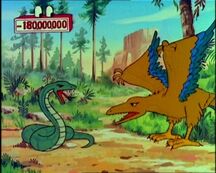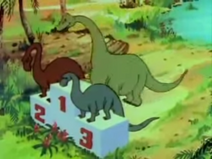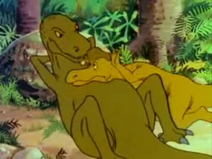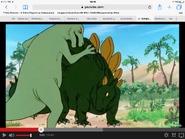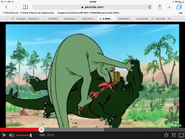'And Earth was created'.... (French: Et la terre fut...) is the first episode of Once upon a time.... Man, and by extension the entire Once upon a time.... series. As the first episode in the series on world history, the episode explains in some detail the history of the planet Earth before the evolution of archaic humans some 700,000 years ago. The next episode is Neanderthal Man.
Plot[]

Earth as a hellish and volcanic landscape, before the first living things appeared.
In the aftermath of a supernova five billion years ago, the Sun and planets form out of a nebula of gas and dust. The Earth, at first moulten and incandescent, cools over hundreds of millions of years, growing larger through continual meteor collisions. Eventually, the first seas and oceans form and the first forms of life, depicted as primæval amoeboids, appear.
After developing slowly for billions of years, life proliferates suddenly some 550 million years ago in the event known as the Cambrian explosion and setting a new standard for the rest of evolution. By 365 million years ago, the first amphibians, called Ichthyostega climb onto dry land four billion years old. Amphibians and their descendants, the reptiles, proliferate on the young Earth. Dinosaurs grow to occupy all niches and habitats and develop into the crocodiles and birds. The continents, up to then together in one mass, split apart and head to their modern positions. Some 70 million years ago, though, climactic upheavals lead to the sudden demise of the dinosaurs, and from the wreckage, a new world emerged.
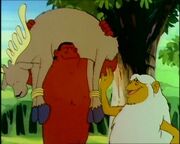
The first appearances of Maestro (right, yellow) and Jumbo (left, brown) in the series, as early humans.
Mammals quickly refill all of the modes of life left behind by their reptilian predecessors. One lineage, the primates, develops three-dimensional vision and intelligence. Eventually, climate change forces them out of the trees, onto the savannas of east Africa, and they start walking on two legs. By 700,000 years ago, a race of early humans called Homo erectus appears and spreads out across the world. We are introduced for the first time to Maestro, Pierre, and Jumbo, and watch tribes of Homo erectus fight for territory and cooperate to hunt mammoths. While caught with his friends in a storm, Maestro discovers fire after a lightning bolt hits a tree. After five billion years of the Earth's preparation, the time is ripe for Man to flourish on the Earth.
Historical inaccuracies[]
- Some of the dates in the series have changed as methods became more precise; Earth formed 4.54 billion years ago, Archaeopteryx lived 150 million years ago, and dinosaurs died 66 million years ago.
- The first single cells were far simpler than amoebae, which have a complex nucleus. More likely first life was more like a simple bacterium alive today called the Mycoplasma or PPLO (pleuropneumonia-like organism) that causes pneumonia in ruminants and venereal disease in Man.
- "Ostracoderms" (armoured, jawless fish) are listed in the series as the first fishes, but in 1999 two soft-bodied jawless fish called Haikouichthys and Myllokunmingia were found.
- Ichthyostega is shown in the series as waddling like a salamander, although it was found in 2005 to have hauled itself like a mudskipper or a seal. It is also now known that Ichthyostega had seven hind toes on each foot, not five.
- Although the series claims all the continents were in a single mass up to the time of the dinosaurs, it is now known the continents come together and split apart in cycles that go on for hundreds of millions of years.
- Crocodiles are no longer held to be the descendants of dinosaurs, although both crocodiles and birds are descended from "thecodonts" (now a disputed term) or ancestral archosaurs, as the series shows. Ancestral archosaurs are not dinosaurs as the series implies, but they are the dinosaurs' ancestors.
- Many depictions of dinosaurs are dated, largely due to the Dinosaur Renaissance of the 1970s.
- Archaeopteryx had only three fingers, with the second finger being attached to the wing, and is now known to have had wings that were white with a black tip, through detailed studies of its feathers, as well as Velociraptor-like feet including the "killing claw". The first bird also lived some 50 million years before the evolution of snakes, and lived in coastal lagoons. Birds would have been descended from dinosaurs (which the series still points out) rather than straight from ancestral archosaurs.

An incorrectly-coloured Archaeopteryx getting into a fight with an anachronistic snake.
- All of the dinosaurs would have stood on legs straight underneath their bodies and kept their tails off the ground.
- Allosaurus, Anatosaurus, and Tyrannosaurus rex had a horizontal stance, rather than the kangaroo-like one shown in the series.
- Stegosaurus had four spikes on its tail, not six like in the series.
- Brontosaurus, Diplodocus, and Brachiosaurus are now known to live in grasslands, rather than in swampy marshlands.
- Anatosaurus did not have a crest as shown in the series. It should also walk mainly on all fours, only switching to a bipedal stance when running.
- Archaeopteryx had only three fingers, with the second finger being attached to the wing, and is now known to have had wings that were white with a black tip, through detailed studies of its feathers, as well as Velociraptor-like feet including the "killing claw". The first bird also lived some 50 million years before the evolution of snakes, and lived in coastal lagoons. Birds would have been descended from dinosaurs (which the series still points out) rather than straight from ancestral archosaurs.
- Plesiosaurs like Elasmosaurus held their necks straight and could not raise them above water.
- Mosasaurs like Tylosaurus had tail flukes and no fringes along the back.
- Ramapithecus (now Sivapithecus) is now believed to be related to orangutans, not humans.
- Homo erectus is no longer called Pithecanthopus as he is called here.
Appearances[]
Historical figures[]
- Alfred Wegener (mentioned)
Years and events[]
- The Big Bang
- 5,000,000,000 BC
- 4,600,000,000 BC
- 4,000,000,000 BC
- 3,500,000,000 BC
- Cambrian period
- 400,000,000 BC
- 365,000,000 BC
- 250,000,000 BC
- 180,000,000 BC
- 70,000,000 BC
- The Extinction of the Dinosaurs
- 60,000,000 BC
- 45,000,000 BC
- 30,000,000 BC
- 25,000,000 BC
- 22,000,000 BC
- 15,000,000 BC
- 12,000,000 BC
- 4,000,000 BC
- 2,000,000 BC
- 1,000,000 BC
- 700,000 BC
Locations[]
- Earth
- Africa
- Tanzania
- Olduvai
- Tanzania
- Europe
- North America
- Africa
Species[]
- Aegyptopithecus
- Allosaurus
- Anatosaurus
- Archaeopteryx
- Archosaur
- Australopithecus
- Brachiosaurus
- Brontosaurus
- Coelacanth
- Deinotherium
- Diplodocus
- Elasmosaurus
- Homo erectus
- Homo habilis
- Ichthyostega
- Kenyapithecus
- Mammoth
- Ostracoderm
- Plesiadapis
- Pliopithecus
- Proconsul
- Pteranodon
- Ramapithecus
- Smilodectes
- Smilodon
- Stegosaurus
- Triceratops
- Trilobite
- Tylosaurus
- Tyrannosaurus rex
Foreign Titles[]
- Original French: Et la terre fut...
- German: Eine neue Welt entsteht
- Italian: Nasce la Terra
- Polish: Była sobie Ziemia
- Spanish: Nace la Tierra
